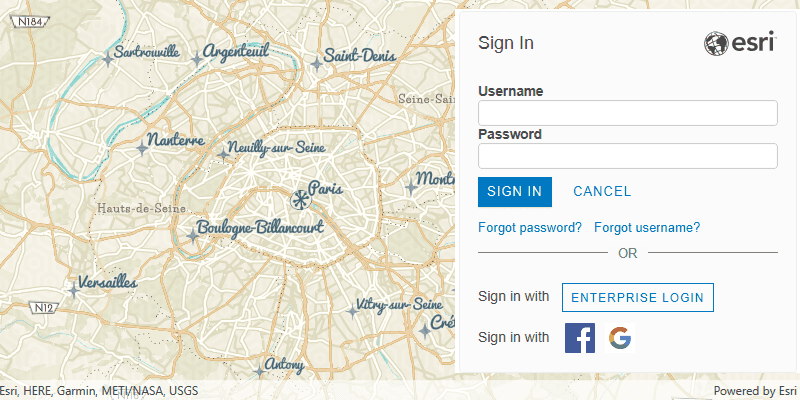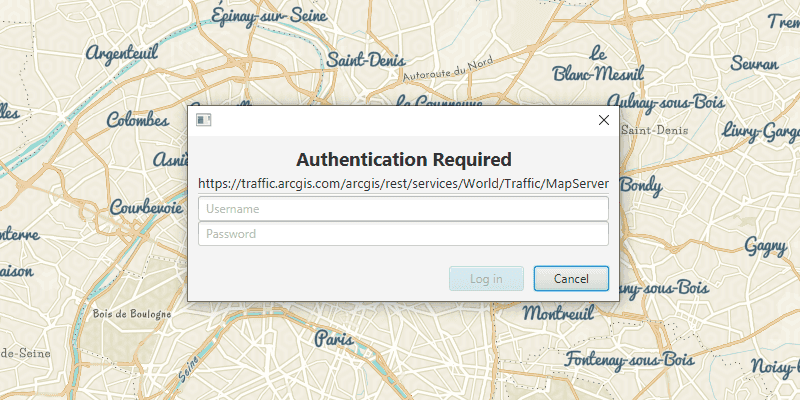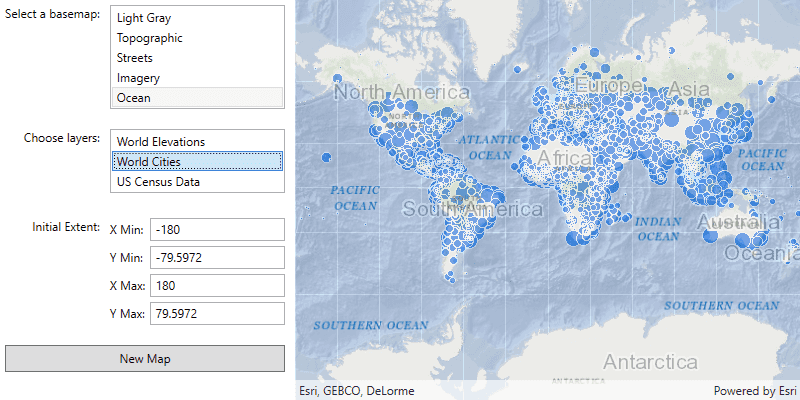ArcGIS supports secure access to ArcGIS services and portal items. It ensures that only valid, authorized users and services can access protected information. To access secure ArcGIS resources, you need an access token that you can obtain by implementing an authentication workflow in your app. The type of authentication you use will depend on the security and access requirements of your app.
There are three types of authentication that can be used to obtain an access token:
- API key authentication: grants a long-lived access token to authenticate requests to ArcGIS services and secure portal items. For more information see the Introduction to API key authentication. Go to the Create an API key tutorial to obtain a new API Key access token using your ArcGIS account. You can configure the API key privileges to authorize access to different services and secure portal items.
- API key access tokens created with an ArcGIS Enterprise account, from ArcGIS Enterprise in version 11.4 onwards, provide access to secure items in an ArcGIS Enterprise portal.
- User authentication: grants a short-lived token, generated via OAuth, giving your application permission to access the ArcGIS services and secure portal items authorized to an existing ArcGIS user's account.
- App authentication: grants a short-lived token, generated via OAuth, authorizing your application to access ArcGIS services and secure portal items.
To make authenticated requests to services, you need to set the token parameter to an access token.
API key authentication
An API Key can grant your public-facing application access to specific ArcGIS services and portal items.
Use API key authentication when you want to:
- Quickly write applications that consume ArcGIS services.
- Provide access to services without requiring users to sign in with an ArcGIS account.
Use an API key in your ArcGIS Runtime app
An API key, can be used to authorize access to specific ArcGIS services and portal items. Go to the Create an API key tutorial to obtain a new access token.
If you set the access token on the
AGSArcGISRuntimeEnvironment
using this access token, all requests made by your app will be authorized using this token. You can also set an access token on any ArcGIS Runtime class that implements
AGSAPIKeyResource
. When you set an access token for a specific class, it will override any access token you may have set on
AGSArcGISRuntimeEnvironment
, enabling more granular usage telemetry and management for ArcGIS Online resources by using the ArcGIS Location Platform.
Classes that implement
AGSAPIKeyResource
include:
-
AGSBasemap -
AGSArcGISSceneLayer -
AGSArcGISTiledLayer -
AGSArcGISVectorTiledLayer -
AGSServiceFeatureTable -
AGSExportVectorTilesTask -
AGSLocatorTask -
AGSGeodatabaseSyncTask -
AGSClosestFacilityTask -
AGSRouteTask -
AGSServiceAreaTask -
AGSExportTileCacheTask
User authentication
User authentication is a set of authentication workflows that allow users with an ArcGIS account to sign into an application and access ArcGIS content, services, and resources. The typical authentication protocol used is OAuth2.0. When a user signs into an application with their ArcGIS account, an access token is generated that authorizes the application to access services and content on their behalf. The resources and functionality available depend on the user type, roles, and privileges of the user's ArcGIS account.
Service your app accesses through user authentication will be billed to the authenticated user's ArcGIS account and its associated ArcGIS subscription. If your application will access your users' secure content in ArcGIS or if you plan to distribute your application through ArcGIS Marketplace, you must use user authentication.
Implement user authentication when you want to:
- Ensure users are signed in and authenticated with their own ArcGIS account.
- Use your app user's credits to pay for their private data, content, or service transactions.
- Limit the length of time users can be signed in to your app with a temporary token.
- Distribute your app through ArcGIS Marketplace.
App authentication
App authentication grant a short-lived access token, generated via OAuth, authorizing your application to access ArcGIS location services, such as basemap layers, search, and routing.
Use app authentication when you want to:
- Access location services with a more secure process and a short-lived token.
- Provide access to services without requiring users to have an ArcGIS account.
Choose an authentication method
The choice of which type of authentication to implement is primarily dependent upon the resources required by your application. Also consider the strengths and limitations of the API or SDK technology on which your application is built. Your choice of authentication method is also affected by the API with which you build your application. For example, ArcGIS Runtime APIs provide an Authentication, with helper methods and patterns to implement user authentication workflows.
| Scenario | Solution |
|---|---|
| Your app requires access only to location services, such as the basemap layer, geocoding, or routing services. | API key authentication |
| Your app allows users to view and edit private data in ArcGIS. | User authentication |
| Your app is on a web server or API backend and requires access only to basemaps and geocoding. | App authentication |
| Your app uses Esri Leaflet, Mapbox GL JS, or OpenLayers. | API key authentication |
| Your app uses an ArcGIS API. | API key authentication or User authentication |
Authentication manager
ArcGIS Runtime APIs contain an Authentication, which provides helper methods and patterns for implementing user authentication workflows.
The
AGSAuthenticationManager
class allows you to manage authentication/security related events.
It raises an
AGSAuthenticationChallenge
whenever an authentication or security issue is encountered anywhere in the API. It also provides a default challenge handler which displays UI containing information about the challenge and presents appropriate options to the user, for instance, requesting a username and password. If you want to handle authentication challenges yourself, for example to display your own custom UI, you can provide your own delegate
It also maintains a cache (in memory) of credentials that have been previously used to satisfy authentication challenges. This allows credentials to be reused, where appropriate, and prevent unnecessary or duplicate challenges from being issued while accessing secure resources from the same security realm. Additionally, the cache can easily be persisted in the keychain (See enable on
AGSCredentialCache
) so that if the app is restarted, the cache is automatically pre-populated with saved credentials and the user does not have to sign in again.
What's Next?
For more information about Security and Authentication, see the Security and Authentication chapter.




